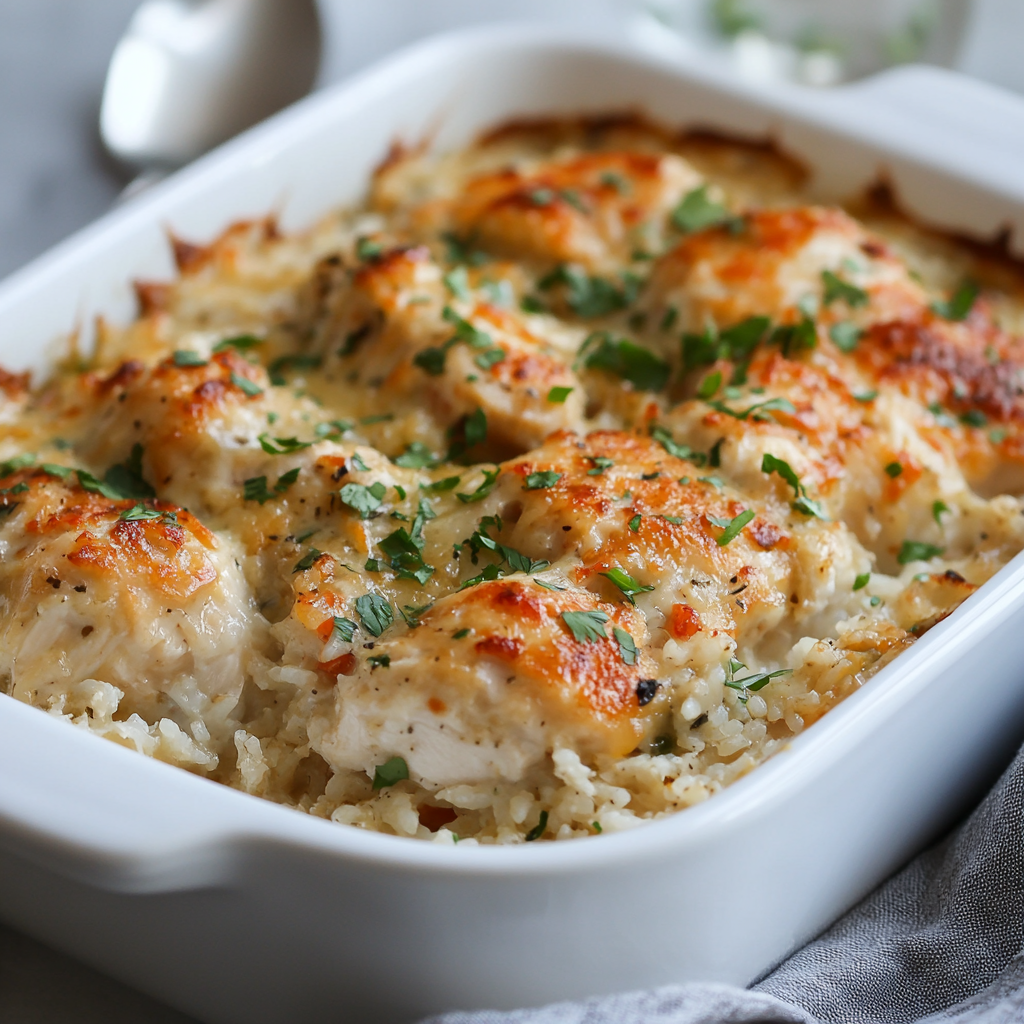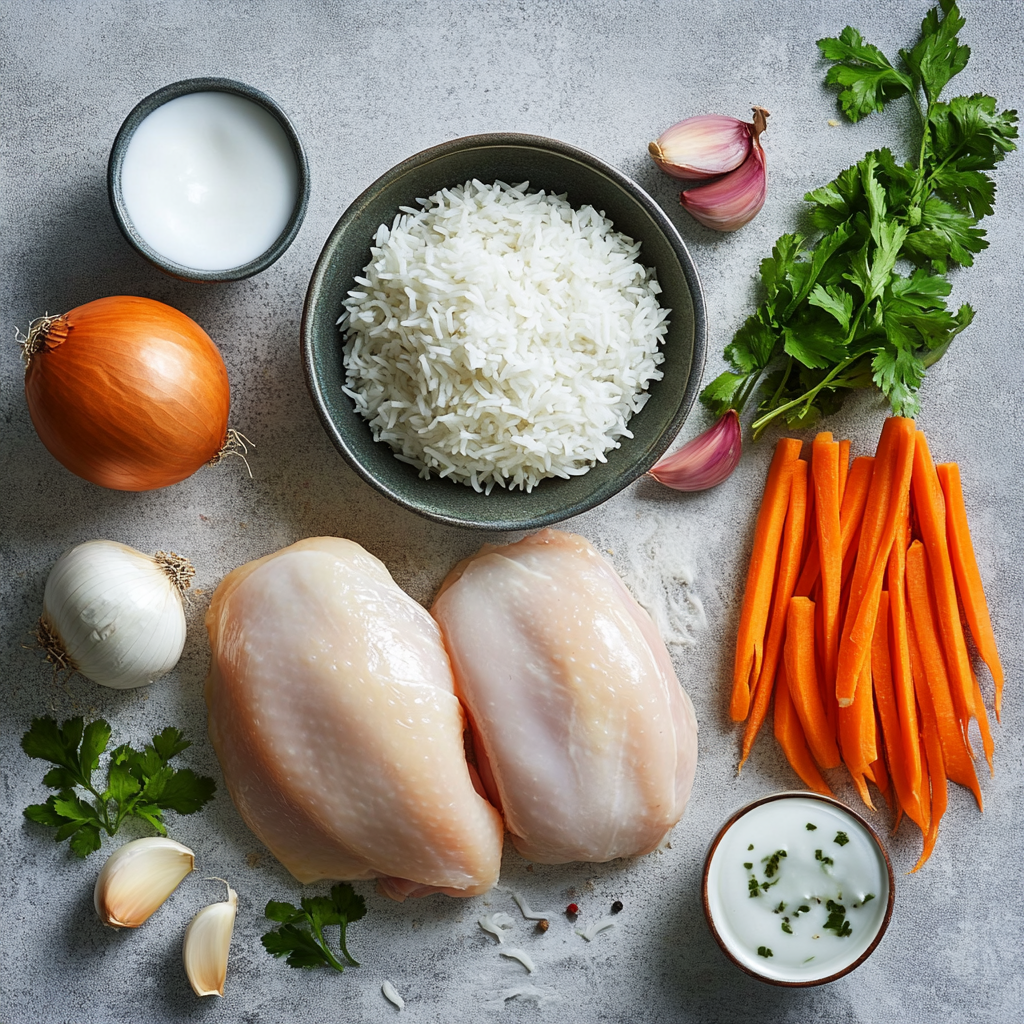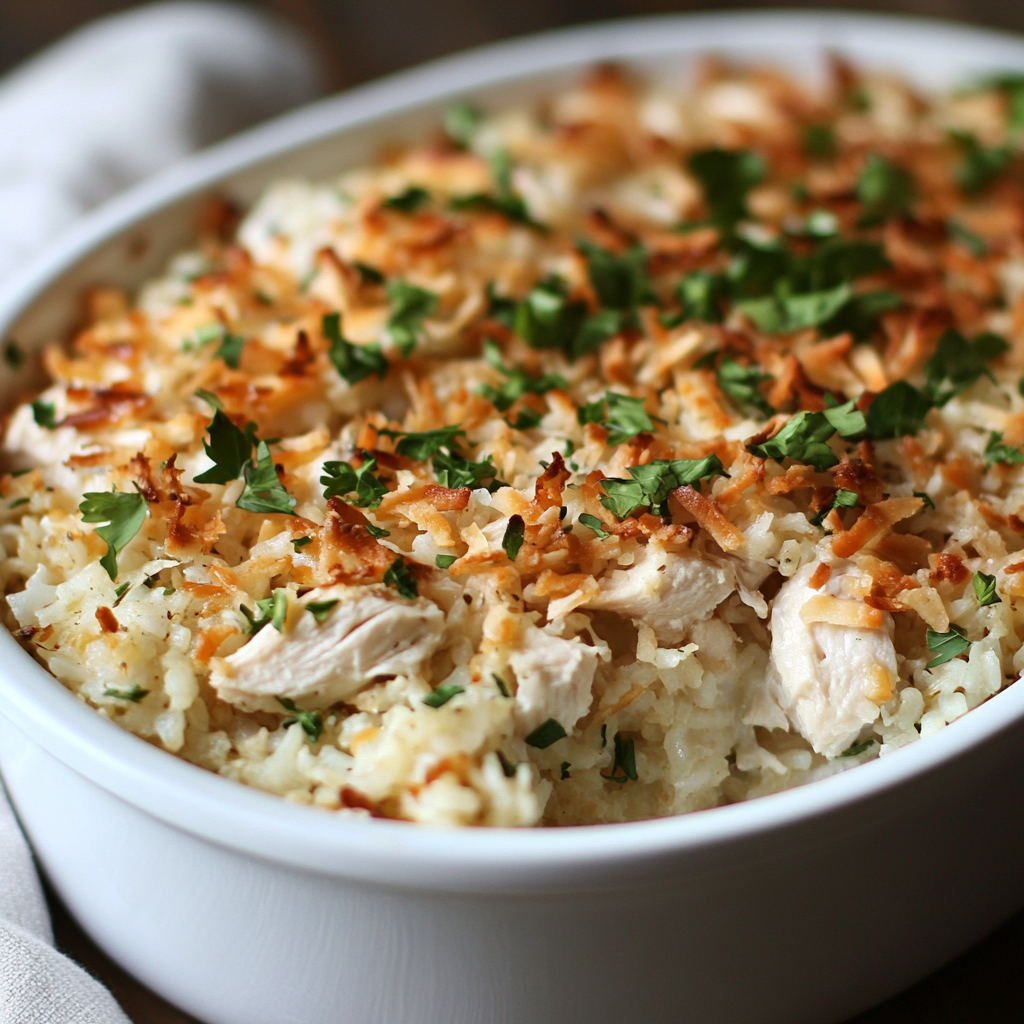If you’re looking for a meal that perfectly balances comfort and flavor, look no further than the Chicken and Coconut Rice Casserole. This dish combines tender, juicy chicken with fragrant, perfectly cooked rice infused with the creamy richness of coconut milk. The result is a hearty casserole that feels like a warm embrace while offering a taste of the tropics.
Ideal for both busy weeknights and special gatherings, this casserole is versatile, easy to prepare, and guaranteed to impress. Whether you’re cooking for your family or entertaining guests, the chicken and coconut rice casserole is the perfect choice when you want something wholesome, delicious, and just a little bit different.
Why You’ll Love This Recipe
- Comfort Meets Exotic Flavor: The creamy coconut milk adds a luxurious richness to the rice, perfectly complementing the tender chicken. It’s comfort food with a tropical twist.
- One-Pan Wonder: This casserole is a convenient one-dish meal. You don’t need to juggle multiple pots and pans, making cleanup a breeze.
- Customizable and Crowd-Pleasing: You can easily add your favorite vegetables, spices, or toppings to make this dish your own. It’s also a hit with both adults and kids alike.
- Meal Prep Friendly: This dish reheats beautifully, making it perfect for leftovers or meal prepping for the week.

Main Ingredients
- 500g Chicken Breasts or Thighs (Cut into Chunks)
- Why It’s Important: Chicken is the star protein in this dish. You can choose chicken breasts for a leaner option or thighs for a juicier, more tender bite.
- Tips:
- Ensure the chicken is cut into evenly sized chunks so it cooks uniformly.
- Marinate the chicken in a bit of salt, pepper, and curry powder for added flavor before adding it to the casserole.
- 1 Cup Basmati Rice (Rinsed)
- Why It’s Important: Basmati rice is perfect for this casserole because of its long grains and aromatic flavor. It pairs beautifully with the coconut milk and spices.
- Tips:
- Rinse the rice thoroughly under cold water until the water runs clear. This removes excess starch and prevents the rice from becoming gummy.
- Soaking the rice for 20 minutes before cooking can help it cook faster and more evenly.
- 1 Can (400ml) Coconut Milk
- Why It’s Important: Coconut milk provides the creamy, rich base of this dish and infuses the rice with tropical flavors.
- Tips:
- Shake the can well before opening, as coconut milk tends to separate.
- Use full-fat coconut milk for the creamiest texture, but light coconut milk works if you prefer a lower-calorie version.
- 1 Cup Chicken Broth
- Why It’s Important: The broth adds depth of flavor and helps cook the rice perfectly by complementing the coconut milk.
- Tips:
- Opt for low-sodium chicken broth so you can control the saltiness of the dish.
- Homemade chicken broth adds an extra layer of freshness if available.
- 1 Onion (Finely Diced)
- Why It’s Important: Onion acts as the aromatic foundation for this dish, bringing sweetness and depth when sautéed.
- Tips:
- Yellow or white onions work best, but red onions can add a slight sweetness if preferred.
- Sauté the onion until soft and translucent for the best flavor.
- 2 Garlic Cloves (Minced)
- Why It’s Important: Garlic enhances the dish with its rich, pungent flavor, balancing the creaminess of the coconut milk.
- Tips:
- Fresh garlic is best for flavor, but garlic paste or powder can be used in a pinch.
- Be careful not to burn the garlic when sautéing—it can become bitter.
- 1 Tablespoon Curry Powder
- Why It’s Important: Curry powder brings warmth and a subtle spiciness to the dish, infusing it with an aromatic depth.
- Tips:
- Choose a mild or medium curry powder to suit your spice tolerance.
- You can mix your own curry powder using turmeric, coriander, cumin, and a pinch of cayenne for a personalized flavor.
- 1 Teaspoon Ground Ginger
- Why It’s Important: Ground ginger adds a gentle spice and earthiness that complements the coconut milk and curry.
- Tips:
- Freshly grated ginger can be used instead of ground ginger for a more vibrant, zesty flavor. Use about 1 tablespoon of fresh ginger.
- Store ground ginger in a cool, dry place to maintain its potency.
- 1 Cup Mixed Vegetables (Carrots, Peas, or Bell Peppers)
- Why It’s Important: Vegetables add color, texture, and nutritional value to the dish.
- Tips:
- Dice the vegetables into similar-sized pieces for even cooking.
- Use frozen mixed vegetables for convenience, or substitute with seasonal fresh produce for a fresher flavor.
Optional Add-ins
For a milder option, use smoked paprika for a hint of heat without overwhelming spice.
Fresh Cilantro (For Garnish)
Why It’s Important: Cilantro adds a bright, herbal note that balances the creaminess of the casserole.
Tips:
Add just before serving to retain its freshness.
For those who dislike cilantro, parsley or green onions can be used as a substitute.
Lime Wedges (For Serving)
Why It’s Important: Lime juice provides acidity and a tangy brightness that cuts through the richness of the coconut milk.
Tips:
Serve lime wedges on the side so everyone can adjust the acidity to their preference.
A Sprinkle of Chili Flakes (For Heat)
Why It’s Important: Chili flakes add a kick of heat, enhancing the overall flavor of the dish.
Tips:
Adjust the amount based on your spice tolerance.
Equipment Checklist
- Casserole dish (9×13 inches works well)
- Large skillet for sautéing
- Knife and cutting board
- Measuring cups and spoons

How to Make Chicken and Coconut Rice Casserole
Preparation Steps:
- Marinate the Chicken:
- Season chicken pieces with salt, pepper, curry powder, and ginger. Let it sit for 10-15 minutes to absorb the flavors.
- Prepare the Rice:
- Rinse the rice under cold water until the water runs clear. This step ensures the rice doesn’t clump during baking.
- Sauté the Aromatics:
- In a skillet, heat 1 tablespoon of oil over medium heat. Sauté the onion and garlic until fragrant and translucent.
Layering the Casserole:
- Create the Base:
- Spread the rinsed rice evenly across the casserole dish.
- Add Layers:
- Arrange the marinated chicken pieces over the rice.
- Add the sautéed onion and garlic mixture.
- Pour the Liquids:
- Combine coconut milk and chicken broth in a bowl. Stir until well mixed and pour over the chicken and rice.
- Top with Vegetables:
- Scatter the mixed vegetables over the top for a colorful and nutritious layer.
Baking Instructions:
- Cover the dish tightly with aluminum foil and bake at 375°F (190°C) for 40 minutes.
- Remove the foil and bake for another 10-15 minutes to allow the top to brown slightly.
Serving Suggestions
- Garnish with fresh cilantro and a squeeze of lime juice for a zesty finish.
- Pair with a crisp green salad or sautéed spinach for a complete meal.
- Serve alongside crusty bread to soak up the creamy sauce.

Variations to Try
Protein Alternatives:
- Swap chicken for shrimp, tofu, or even turkey for a unique twist.
Spice Adjustments:
- Add chili powder or fresh jalapeños for extra heat.
Rice Substitutes:
- Brown rice or quinoa can be used, though they may require slightly longer cooking times.
Storage and Reheating Tips
- Refrigeration: Store leftovers in an airtight container for up to 3 days.
- Freezing: Cool completely and freeze for up to 2 months. Thaw overnight before reheating.
- Reheating: Warm in the oven at 350°F (175°C) for 10-15 minutes, or microwave in 1-minute intervals until heated through.
1. Can I Use Brown Rice Instead of Basmati?
- Yes, but there are adjustments you’ll need to make:
- Cooking Time: Brown rice takes longer to cook than basmati rice due to its higher fiber content. Expect it to take 40-50 minutes to cook fully, compared to the 20-25 minutes for basmati.
- Liquid Ratio: Brown rice absorbs more liquid, so you’ll need to increase the amount of chicken broth and coconut milk. A good starting ratio is 2.5 cups of liquid for every cup of brown rice.
- Flavor Considerations: The nutty flavor of brown rice complements the dish well but has a slightly chewier texture. Ensure the chicken and vegetables are cooked appropriately so they don’t overcook while waiting for the rice to finish.
2. Is There a Dairy-Free Alternative to Coconut Milk?
- Yes, but it depends on the flavor profile you want to achieve:
- Almond Milk: A lighter, mildly nutty alternative that keeps the dish dairy-free. It’s less creamy than coconut milk, so consider adding a tablespoon of almond butter or a splash of full-fat almond cream for richness.
- Oat Cream: A thicker, creamier dairy-free option that works well as a substitute. It mimics the texture of coconut milk but offers a more neutral flavor.
- Cashew Milk: Another creamy, dairy-free option that pairs well with curry flavors.
- Important Tip: Coconut milk adds a tropical flair to this dish. If you substitute it with almond or oat-based alternatives, the flavor will be milder. Add a bit of extra curry powder or ground ginger to maintain the dish’s bold taste.
3. How Do I Make This Dish Spicier?
- Customize the spice level with these tips:
- Chili Flakes: Add a teaspoon of chili flakes to the casserole before baking. You can also sprinkle more on top when serving for an added kick.
- Spicy Curry Powder: Replace mild or medium curry powder with a hot version for an all-around heat boost.
- Fresh Chilies: Dice fresh red or green chilies (like Thai or Serrano chilies) and sauté them with the onions and garlic at the start of the recipe. This adds a more vibrant and fresh heat.
- Cayenne Pepper: Add 1/4 to 1/2 teaspoon of cayenne pepper for a sharp, spicy note that balances the creamy coconut milk.
- Hot Sauce: Serve with a drizzle of your favorite hot sauce on top for those who love bold heat.
4. Can I Prepare This Casserole in Advance?
Freezing Option: This casserole freezes well. After assembling, cover it tightly and freeze it for up to 2 months. Thaw it overnight in the fridge and bake as directed.
Yes, and here’s how to do it:
Assembling in Advance: You can fully assemble the casserole with all ingredients in a baking dish, cover it tightly with plastic wrap or aluminum foil, and refrigerate it for up to 24 hours before baking. This allows the flavors to meld together.
Baking from Refrigeration: When ready to bake, remove the casserole from the fridge and let it sit at room temperature for about 20-30 minutes. This ensures even cooking and prevents the dish from cracking due to sudden temperature changes.
Reheating: If you’ve already baked the casserole and want to reheat it, cover it with foil and warm it in a 350°F (175°C) oven for 20-30 minutes, or until heated through. Adding a splash of chicken broth or coconut milk before reheating helps keep the rice moist.
Are There Gluten-Free Options?
The recipe is naturally gluten-free as long as your chicken broth and curry powder are certified gluten-free.
Conclusion
The chicken and coconut rice casserole is a satisfying, flavorful dish that’s easy to prepare and perfect for any occasion. Its creamy texture and tropical notes make it a crowd favorite. Try this recipe today and let the comfort food magic transform your mealtime!
Have your own twist on this casserole? Share your version in the comments below!
